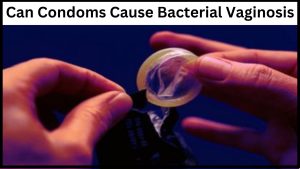
Can Condoms Cause Bacterial Vaginosis? – Have you ever wondered if using condoms can lead to the development of bacterial vaginosis (BV)?
It’s a common concern among individuals who prioritize safe sex practices.
Today, we’ll explore this topic and provide you with answers to various related questions, such as why some people experience urinary tract infections (UTIs) when using condoms, which condoms are less likely to cause UTIs, and the best lubricants for UTI prevention.
So, if you’ve been curious about the connection between condoms and bacterial vaginosis, keep reading to find out more.
Table of Contents
Can Condoms Cause Bacterial Vaginosis: Research & Factors Involved
Understanding Bacterial Vaginosis
Bacterial vaginosis (BV) is a common vaginal infection caused by an imbalance in the vaginal flora.
This condition occurs when the normal balance of bacteria in the vagina is disrupted, allowing harmful bacteria to multiply.
While the exact cause of BV is still not fully understood, certain factors such as sexual activity, multiple partners, douching, and hormonal changes may contribute to its development.
BV is not considered a sexually transmitted infection (STI), although it can sometimes occur after sexual contact.
What Are Condoms?
Condoms are barrier devices made of latex or other materials that are used during sexual intercourse to prevent pregnancy and reduce the risk of sexually transmitted infections (STIs).
They act as a physical barrier, preventing direct contact between the penis and the vagina, thereby reducing the transmission of STIs, including HIV.
Condoms are available in various types, including male condoms and female condoms, to suit different preferences and needs.
The Link Between Condoms and Bacterial Vaginosis
The association between condoms and bacterial vaginosis has been a topic of debate and research.
Some studies suggest that consistent use of condoms may decrease the risk of BV, as they provide a protective barrier against potentially harmful bacteria.
However, other studies have shown a potential link between condom use and an increased risk of BV.
It is important to note that the causal relationship between condoms and BV is yet to be fully understood, and more research is needed to establish a definitive conclusion.

Common Symptoms Of Bacterial Vaginosis
Bacterial vaginosis can cause a range of symptoms, although some women may remain asymptomatic.
Common signs and symptoms of BV include:
Abnormal vaginal discharge
One of the hallmark symptoms of BV is a thin, grayish-white discharge that may have a foul, fishy odor.
The discharge is often more noticeable after sexual intercourse or during menstruation.
Unpleasant odor
The characteristic foul odor associated with BV is typically described as a fishy smell.
This odor may be more pronounced after sexual activity or when the vaginal pH level is disrupted.
Burning or itching sensation
Some women with BV may experience a burning or itching sensation in the vaginal area.
This discomfort can be mild or severe and may be more noticeable after intercourse.
Discomfort during sex
BV can cause vaginal irritation and discomfort during sexual intercourse.
This can range from mild discomfort to more intense pain or a burning sensation.
Related complications
Although BV is not typically considered a serious condition, if left untreated, it can increase the risk of certain complications, such as pelvic inflammatory disease (PID), post-surgical infections, premature birth, and an increased susceptibility to other sexually transmitted infections (STIs).

Research Studies On Condoms And Bacterial Vaginosis
Several research studies have investigated the potential relationship between condom use and the risk of bacterial vaginosis.
The findings have been conflicting, with some studies suggesting a protective effect of condoms against BV, while others have found an association between condom use and an increased risk of BV.
These conflicting results may be attributed to various factors, such as differences in study design, population characteristics, and the presence of other contributing factors.
Factors Contributing To Bacterial Vaginosis
While the exact cause of bacterial vaginosis is unknown, several factors have been identified that may contribute to its development. These factors include:
Imbalance in vaginal flora
BV occurs when the normal balance of bacteria in the vagina is disrupted, leading to an overgrowth of harmful bacteria and a decrease in beneficial bacteria.
This imbalance can be caused by various factors, including sexual activity, douching, hormonal changes, and the use of certain medications.
Sexual activity and multiple partners
Engaging in sexual activity, especially with multiple partners, has been associated with an increased risk of BV.
This may be due to the exchange of bacteria during sexual contact or the disruption of the vaginal flora.
Douching and feminine hygiene products
Douching, the practice of cleansing the vagina with water or other solutions, can disrupt the natural pH and bacterial balance in the vagina, increasing the risk of BV.
The use of scented soaps, feminine sprays, and other hygiene products can also irritate the vagina and contribute to the development of BV.
Hormonal changes
Fluctuations in hormone levels, particularly estrogen, can alter the vaginal environment and make it more susceptible to bacterial overgrowth.
This can occur during pregnancy, menopause, and certain phases of the menstrual cycle.
Weakened immune system
A weakened immune system can compromise the body’s ability to fight off infections, including BV.
Medical conditions such as HIV/AIDS, diabetes, and chronic illnesses can increase the risk of developing BV.
Genetic predisposition
There may be a genetic predisposition to bacterial vaginosis, as some studies have suggested a higher prevalence of BV among certain ethnic groups.
Further research is needed to better understand the genetic factors involved in BV development.

Preventing Bacterial Vaginosis
While it may not be possible to eliminate the risk of bacterial vaginosis, there are steps you can take to reduce your chances of developing this condition.
These preventive measures include:
Maintaining proper vaginal hygiene
It is important to practice good vaginal hygiene to help maintain a healthy balance of bacteria in the vagina.
This includes gentle cleansing with mild, unscented soap and water, avoiding excessive washing, and refraining from using douches or other cleansing agents.
Avoiding irritants and allergens
The use of scented soaps, bubble baths, and other irritants can disrupt the natural pH balance of the vagina and increase the risk of BV.
It is best to avoid these products and choose hypoallergenic alternatives.
Practicing safe sex
Consistent and correct use of condoms during sexual intercourse can help reduce the risk of bacterial vaginosis.
It is important to choose condoms made from materials that are not likely to cause irritation or allergic reactions.
Using probiotics and natural remedies
Certain strains of beneficial bacteria, known as probiotics, can help restore the natural balance of bacteria in the vagina.
Probiotics can be taken orally or applied topically in the form of suppositories or creams.
Additionally, some natural remedies, such as tea tree oil and hydrogen peroxide, may have antimicrobial properties that can help prevent or treat BV.
Regular gynecological check-ups
Regular visits to a healthcare provider for gynecological exams can help detect and treat any vaginal infections, including BV, early on.
Your healthcare provider can guide you on preventing and managing BV, as well as address any concerns or questions you may have.

Choosing The Right Type Of Condoms
When it comes to choosing condoms, it is important to consider factors that can affect vaginal health and the risk of BV.
Some tips for selecting the right type of condoms include:
Latex vs non-latex condoms
Latex condoms are the most common type and are generally effective in preventing both pregnancy and STIs.
However, some individuals may be allergic to latex and may experience irritation or discomfort when using latex condoms.
In such cases, non-latex condoms made from materials like polyurethane or polyisoprene can be used as an alternative.
Avoiding spermicides and fragrances
Spermicides and fragrances can contain chemicals that may disrupt the natural balance of bacteria in the vagina and increase the risk of BV.
It is best to choose condoms without spermicides and opt for unscented varieties.
Quality and reliability
Choosing condoms from reputable brands and ensuring that they meet quality and safety standards is essential.
Look for condoms that are FDA-approved and manufactured according to recognized quality control guidelines.
Proper storage and expiration dates
Condoms should be stored in a cool, dry place away from direct sunlight.
Check the expiration dates before use and discard any expired condoms.
Using expired condoms may compromise their effectiveness and increase the risk of bacterial contamination.

Practicing Good Hygiene For Vaginal Health
In addition to using condoms and practicing safe sex, maintaining good vaginal hygiene can help promote optimal vaginal health and reduce the risk of BV.
Some tips for practicing good hygiene include:
Importance of cleanliness and dryness
Keeping the vaginal area clean and dry is important for maintaining a healthy balance of bacteria.
After using the toilet, make sure to wipe from front to back to prevent the spread of bacteria from the anal area to the vagina.
Proper wiping techniques
Gently patting or blotting the vaginal area with toilet paper is recommended, as excessive wiping can irritate.
Avoid using harsh or scented toilet paper.
Avoiding excessive washing and douching
While it is important to keep the vaginal area clean, excessive washing, especially with scented soaps or cleansers, can disrupt the natural pH balance and increase the risk of BV.
Douching should be avoided altogether, as it can flush out beneficial bacteria and disrupt the vaginal flora.
Wearing breathable underwear
Choosing underwear made from breathable fabrics like cotton can help promote airflow and reduce moisture in the vaginal area.
Avoid tight-fitting or synthetic materials that can trap moisture and create an environment conducive to bacterial growth.
Maintaining a Healthy Lifestyle
A healthy lifestyle, including a balanced diet, regular exercise, and adequate sleep, can help support overall vaginal health.
Avoiding excessive stress and taking measures to manage stress levels can also contribute to a healthier vaginal environment.
Conclusion
In conclusion, the relationship between condoms and bacterial vaginosis is complex and requires further research for a definitive conclusion.
While condoms are generally considered effective in preventing STIs, including BV, some studies have shown conflicting results regarding their association with BV.
Practicing good vaginal hygiene, using condoms correctly and consistently, and following other preventive measures can help reduce the risk of developing BV.
It is important to consult with a healthcare provider for personalized advice and guidance on maintaining vaginal health and preventing bacterial vaginosis.

